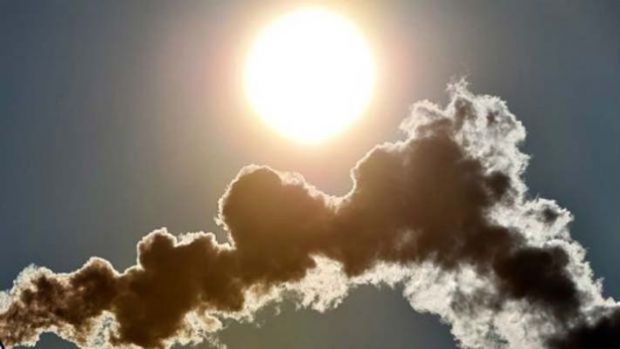Pollution Vs Development
Posted December 2nd, 2015, 10:05 AM IST

According to the Better Climate, Better Growth: The New Climate Economy Report released in September 2014, in the 15 countries with the highest greenhouse gas emissions, the damage to health from poor air quality, largely associated with the burning of fossil fuels, is valued at an average of 4.4% The WWF says that we have lost more than half of the animals on our planet in the last 40 years. A study called ‘Accelerating extinction risk from climate change’ was published in the Science magazine in May 2015.
It said that if manmade greenhouse gas emissions continue at their current record-breaking rate, leading to a temperature rise of more than 4C by the end of the century, 16% of species, or one in six, face extinction. According to Nature.com, mercury levels in the upper ocean have tripled since the beginning of the Industrial Revolution, and human activities are to blame. Researchers collected thousands of water samples during eight research cruises to the North and South Atlantic and Pacific oceans between 2006 and 2011 and . Their analysis reveals that human activities — mostly the burning of fossil fuels, but also mining — had boosted mercury levels in the upper 100 metres of the ocean by a factor of 3.4 since the beginning of the Industrial Revolution.
Deaths because of air pollution are also on the increase. China’s air pollution has cut life expectancy by an average of 5.5 years in the north of the country. The Shanghai Academy of Social Sciences in 2014 stated that “The pollution index (in Beijing) nears extreme levels, and is near a level that is no longer livable for human beings.” Delhi is now the most polluted city in the world, where more than 40 people per day die from respiratory illnesses. 13 of the 20 worst-polluted cities worldwide are in India where more people die of asthma than anywhere else in the world.
These pollution levels in India are not about to come down in a hurry as 60% of the electricity generation is still from burning coal. The International Energy Agency estimates that by the end of the decade, India will move ahead of the U.S. to be the second-largest coal market in the world (after China). Under current plans to increase the number of coal-fired power plants in India, premature deaths linked to air pollution could double to 220,000 per year by 2030. It is understandable that India needs to generate more and more electricity for development. We have close to half the country that is suffering from lack of electricity. It is estimated that India loses $68 billion, of its GDP, to electricity shortages. These numbers are ample justification for the country’s hunger for electricity.
The big question is whether coal fired electricity plants are the only way to generate electricity, or are there other solutions for clean electricity? Considering emissions from coal fired electricity plants are causing so much damage to the environment in general and specifically and directly to the health of the people, should countries like India commit to abandoning coal fired electricity generation plants completely?
China will ban all coal use in Beijing by 2020. When will countries like India stop burning coal to generate electricity and adopt ONLY clean forms of electricity? Is this even possible? Yes it is.
(The writer is an author, speaker, trainer, consultant, an entrepreneur and an expert in applied sustainability. Visit: www.CBRamkumar.com.)
- Kukatpally, Old City and Tolichowki made their mark as the city's top street food hubs
- Political leaders attend grand Alia Balai programme in Hyderabad
- Over 7,500 daily steps before surgery tied to fewer complications
- Deepika talks mental health with corporate bosses
- Sweet Shop - Owners of Calcutta and Other Ideas: Taste the universe
- Life in motion
- Witness The Most Riveting Courtroom Drama of The Year
- Mind-Body Synergy: Embracing Profound Connection Between Mental and Physical Health
- Red Haute Alert
- WWF-India Hosts Second Earth Series Talk: "A Tale of Two Cats"
- Hyderabad entrepreneurs ‘Modify’ clothes from aloe vera to orange peel
- How to Apply Onion Juice to Hair
- Patriotism is in thing, it’s Tricolour everywhere
- Celebs too wear fakes of reputed brands
- Elon Musk on fun trail says 'buying Coca Cola next'
More Lifestyle News
- Vijay Sethupathi’s heartwarming selfie with elderly voter goes viral
- ‘aha’ unveils promo for ‘Sarkaar Season 4’ featuring Sudigali Sudheer as host
- Record rains in UAE flood Dubai International Airport, disrupt travels
- Akshay Kumar joins Vishnu Manchu’s ‘Kannappa’ shoot in Hyderabad
- Suhana Khan shares joyful photos with Ananya Panday after KKR victory
- Kartik Aaryan says he’s ready for love, asks Neha Dhupia to find someone for him
- Indian film stars extend Ugadi, Gudi Padwa, and Navreh wishes
- Mrunal Thakur honored for ‘Hi Nanna’ performance, details inside
- Prithviraj-starrer ‘The Goat Life’ rakes it in: Rs 100 cr in 9 days
- Rashmika Mandanna’s ‘Srivalli’ takes center stage in Pushpa 2: The Rule poster drop
A PHP Error was encountered
Severity: Warning
Message: file_get_contents(): http:// wrapper is disabled in the server configuration by allow_url_fopen=0
Filename: views/newsdetails.php
Line Number: 29
Backtrace:
File: /home5/am2pm/public_html/application/views/newsdetails.php
Line: 29
Function: file_get_contents
File: /home5/am2pm/public_html/application/controllers/News.php
Line: 135
Function: view
File: /home5/am2pm/public_html/application/controllers/News.php
Line: 83
Function: newsdetails
File: /home5/am2pm/public_html/index.php
Line: 315
Function: require_once
A PHP Error was encountered
Severity: Warning
Message: file_get_contents(http://www.indiaaffiliates.in/ads.php?size=300X250): failed to open stream: no suitable wrapper could be found
Filename: views/newsdetails.php
Line Number: 29
Backtrace:
File: /home5/am2pm/public_html/application/views/newsdetails.php
Line: 29
Function: file_get_contents
File: /home5/am2pm/public_html/application/controllers/News.php
Line: 135
Function: view
File: /home5/am2pm/public_html/application/controllers/News.php
Line: 83
Function: newsdetails
File: /home5/am2pm/public_html/index.php
Line: 315
Function: require_once














